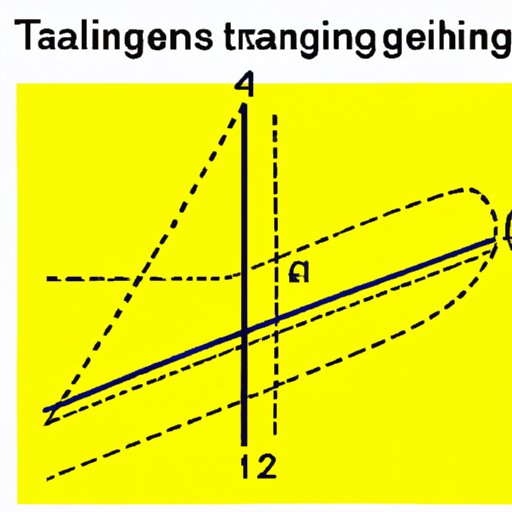
Finding Tangent Lines: A Step-by-Step Guide on How to Master the Formula
Have you ever had a tough time solving math problems that required finding the tangent line of a curve? The task can be daunting, especially for students who are just starting to learn more advanced math concepts. However, knowing how to find a tangent line can help with a wide range of real-life problems across various fields. In this article, we’ll take a closer look at tangent lines, including a step-by-step guide, real-life applications, misconceptions, and how to compare them with other mathematical concepts. Read on to learn more.
Step-by-Step Guide
A tangent line is a straight line that touches a curve at a single point and has the same slope as the curve at that point. It’s essential to learn how to find a tangent line to help you solve problems related to calculus, engineering, physics, and other fields. Here’s a guide to help you:
- Determine the point of tangency: First, determine the point on the curve where you want to find the tangent line. For example, if you want to find the tangent line that passes through the point (3, 7) on the curve y = x^2 + 1, you’ll start by identifying the x-value (3) and its corresponding y-value (10).
- Identify the slope of the curve at the point: To find the tangent line’s slope, you’ll need to calculate the derivative of the curve function at the point of tangency. For the curve y = x^2 + 1, the derivative is y’ = 2x. So, at the point (3, 10), the slope of the curve is y’ = 2(3) = 6.
- Write the equation of the tangent line: Once you have the slope of the tangent line and the point of tangency, you can use the point-slope formula to find the equation of the tangent line. The point-slope formula is y – y1 = m(x – x1), where m is the slope, (x1, y1) is the point of tangency, and (x, y) is any other point on the tangent line. For our example, if we use (3, 10) as the point of tangency, the equation of the tangent line is y – 10 = 6(x – 3), which simplifies to y = 6x – 8.
Keep in mind that finding the tangent line’s equation may seem straightforward, but it’s crucial to double-check your work to avoid mistakes and ensure that you’ve solved the problem correctly.
Real-Life Applications
Tangent lines are essential in analyzing motion, physics, and engineering problems. Here are some ways tangent lines can be used in real-life situations:
- Optimizing production: Engineers may use tangent lines when designing machines or solving problems related to production-line optimization. They can use tangent lines to determine the maximum or minimum point of a curve, which can help in developing strategies for minimizing costs or maximizing output.
- Finding trajectory: In physics, tangents are essential in calculating the velocity or acceleration of objects. For instance, imagine a ball that follows a parabolic trajectory when launched into the air. If we launch the ball at a certain angle, we can use tangent lines to calculate its velocity and predict its landing point.
- Investigating rates of change: Tangent lines can be used to understand rates of change in real-life situations. For example, if we know the tangent line of a revenue function, we can use it to understand the company’s rate of revenue growth.
By incorporating tangent lines into practical applications, individuals can understand complex mathematical concepts in a more comfortable and accessible manner.
Video Tutorial
For visual learners, a video tutorial can help them understand the concepts better. Let’s quickly go through the steps to get an idea of what to expect.
Common Misconceptions
There are several common misconceptions about tangent lines that people need to understand to avoid errors when working on calculus problems.
- Tangent lines and secant lines are not the same thing: A tangent line touches a curve at one point, while a secant line touches a curve at two points.
- Tangent lines don’t intersect curves: A tangent line touches a curve at exactly one point, meaning they do not intersect.
- A curve can have multiple tangent lines: At some points, curves can have more than one tangent line.
These misconceptions may seem minor, but they can have a significant impact on the accuracy of the final result. The key is to be precise and accurate at every step, double-checking all calculations and ensuring that you understand the concepts completely.
Comparison with Other Concepts
Tangent lines are just one part of calculus; they are similar to other mathematical concepts like slopes and derivatives. However, they have their unique characteristics that make them essential in analyzing curves and their behavior.
For example, the derivative of a curve function is essential in finding the slope of the tangent line, but the derivative is a more general concept that can be used in other contexts, such as optimization problems, roots, and finding inflection points.
Slope is also a vital concept, but unlike tangent lines, it is a line’s characteristic rather than a curve’s. Slope measures the steepness or inclination of a line.
In summary, tangent lines differ from other mathematical concepts because they only apply to curves and are used in determining the rate of change of the curve at a specific point.
Conclusion
In conclusion, tangent lines may seem like an intimidating concept, but they play a crucial role in real-life applications and are easy to understand with practice. From finding the velocity of a moving object, using them to design production lines, to tracking a company’s growth, tangents come in handy and have endless practical applications. Don’t hesitate to ask questions, and always practice your skills to continuously improve your understanding of this fundamental mathematical concept.





